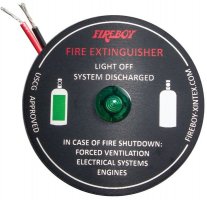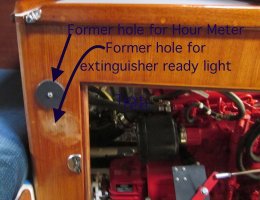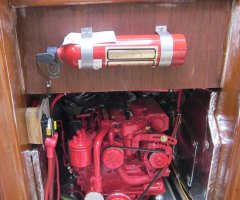Our '88 boat has an original Halon extinguisher mounted in the engine compartment, and there was also a System Ready indicator light mounted on the side of the engine bulkhead beside the large access door to the engine.
My surmise was that this was standard, but a friend with a sister ship has no such system nor any sign that one was ever installed.
Costly then, if it was an option. I did a quick search and if this bottle had not passed a recent inspection the replacement for a "Halon equivalent" bottle would be about $500.
A surveyor friend who is also an ABYC electrician tells me that the extinguisher system is not actually 'required' on a diesel aux boat, but that if it is there the light indicating that it is full/armed must also be there. OK so far. But then, current ABYC regs are that the light be mounted adjacent to the engine instruments at the helm position.
Easy to do for a power boat with their big dash board..... not very possible for a sailboat with a tiller or binnacle where the minimal engine controls are located somewhere near the side -- low down -- in the cockpit area.
After pondering what EY had in mind, it seems logical (?) that they wanted that light located where you might be tempted to open up the engine because you had just shut down due to seeing smoke or some similar indication that you had a major problem in the engine. Perhaps.
Further, if the extinguisher HAD discharged, you would certainly not want to allow a fresh breeze of oxygen into the area to reignite it. Matter of fact you should already have shut off the diesel valve at the tank (under a settee on our model of boat).
So now I have on hand the new light and cover plate with peel-&-stick adhesive. The light light itself takes only a 5/16" hole (about like the old light that had recently had the bulb fall apart from age).
So i could install it, perhaps where I removed the original round hour meter. Tidy, and true to the presumed factory thinking for location. But not "approved" by the ABYC. (sigh)
Plan B is to try to put the light actually near our engine cockpit panel. It might be possible to mount it on the surface on the left side of the new hinged clear cover plate. Surveyor sez she would pass this as a good faith effort to comply, realizing that the ABYC rule is really (and almost solely) focused on power boats. That installation would be difficult at best, and the escutcheon plate around the light is not really waterproofed around the little led bulb anyway.
****SO....... how is or was this done on your Ericson or Olson??

Did your boat come with a Halon bottle?
(I sort of presume that most of you with a gasoline engine like an A4 do have this in place already.)
Your thoughts? Comments?
As always, Thanks !
Loren
My surmise was that this was standard, but a friend with a sister ship has no such system nor any sign that one was ever installed.
Costly then, if it was an option. I did a quick search and if this bottle had not passed a recent inspection the replacement for a "Halon equivalent" bottle would be about $500.
A surveyor friend who is also an ABYC electrician tells me that the extinguisher system is not actually 'required' on a diesel aux boat, but that if it is there the light indicating that it is full/armed must also be there. OK so far. But then, current ABYC regs are that the light be mounted adjacent to the engine instruments at the helm position.
Easy to do for a power boat with their big dash board..... not very possible for a sailboat with a tiller or binnacle where the minimal engine controls are located somewhere near the side -- low down -- in the cockpit area.
After pondering what EY had in mind, it seems logical (?) that they wanted that light located where you might be tempted to open up the engine because you had just shut down due to seeing smoke or some similar indication that you had a major problem in the engine. Perhaps.
Further, if the extinguisher HAD discharged, you would certainly not want to allow a fresh breeze of oxygen into the area to reignite it. Matter of fact you should already have shut off the diesel valve at the tank (under a settee on our model of boat).
So now I have on hand the new light and cover plate with peel-&-stick adhesive. The light light itself takes only a 5/16" hole (about like the old light that had recently had the bulb fall apart from age).
So i could install it, perhaps where I removed the original round hour meter. Tidy, and true to the presumed factory thinking for location. But not "approved" by the ABYC. (sigh)
Plan B is to try to put the light actually near our engine cockpit panel. It might be possible to mount it on the surface on the left side of the new hinged clear cover plate. Surveyor sez she would pass this as a good faith effort to comply, realizing that the ABYC rule is really (and almost solely) focused on power boats. That installation would be difficult at best, and the escutcheon plate around the light is not really waterproofed around the little led bulb anyway.
****SO....... how is or was this done on your Ericson or Olson??
Did your boat come with a Halon bottle?
(I sort of presume that most of you with a gasoline engine like an A4 do have this in place already.)
Your thoughts? Comments?
As always, Thanks !
Loren
Attachments
Last edited:



